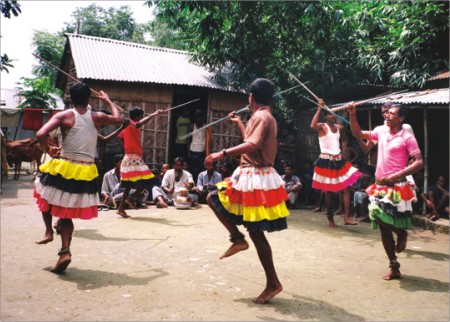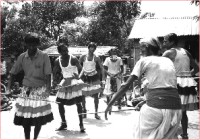| From Manikganj
Lathi Khela of Bangladesh
Simon Zakaria

Lathi Khela, or what might be translated as stick sports, is a traveling art form. Ordinary people of the villages arrange these games on occasions such as the Bangla New Year, Weddings and Annaprashans. A group of stick players is hired. These folks enter the village loudly announcing their arrival, sometimes singing. Hearing this, the villagers come out of their houses. Sometimes even people from surrounding villages will run off to see the show.
Women, men, children-everybody is interested in the show- usually there is a pre-set spot for the event to take place. The players then take the food given to them by the audience and then take their place. They start calling out to admonish each other, “O o o/ tumi je kemon beer/ ta janbo ami re/ o o o” (Oh I will find out how brave you truly are!). Then all touch the ground as a sign of respect and run indoors to get dressed. This is when the music show starts. Band members throw a mat down on the ground and start playing drums, cymbals and kartals. In the meantime, the fighters are getting dressed indoors, wearing white dhotis and colored ghaghras. Carrying colored sticks in their hands, they come down to the field. They start yelling out threats once more, and sometimes engage in some comedic banter. Then they start to circle the whole field.
Then the games start. The whole group splits up into two and fights. They attack each other with their sticks, and sometimes they warn each other, “Don't dare!” One of the rules of this game is that when a fighter is hit in the body the fight stops immediately. The music also stops immediately. Game over.

As the music goes on, sometimes a musician will get up and start signaling that he wants to see a particular type of stick play. In this case, a fighter will have a short conversation with one of the musicians and hear what new style he is being told to adopt. As the fight goes on, a musician will try to interrupt and say, “hey mister”, to which the head fighter says, “can't you see that we're fighting? Keep playing your music!” Musician says, “hold on, I've heard this myself, you know what this family has said to me?” Fighter replies, “what?” This banter goes on and on for quite some time, sometimes verging off into philosophical speculation. For example, the fighter might say, “there are two parts of me, one woman, one man. Right now the woman is fighting.” And so on. Then the musician might suggest some style which the fighter takes up and the fighting resumes. This is not always done in groups- sometimes there are one on one fights. For a one day show, a group usually charges somewhere between taka 500 to taka 2000.
 Lathi Khela is just skilled theater, like a kind of circus. There was a time when this was prevalent throughout Bangladesh. But the scope of the art has become smaller with the times, and understandably so. Presently, this show can only be seen in Manikganj, Joypurhat, Narail, Srimangal, Kishoreganj, Mymensingh, Netrokona, Kushtia, Jhenaidah and just a few other regions. In the Lathi Khela shows of Manikganj, sometimes singing and dancing is also presented. Stand-up comedians also show up wearing bright clothing and make topical jokes, mainly on the social customs of the region. Needless to say, there is a lot of satire in this and usually these comedians get big laughs. In between the jokes and the fights there are some fairly 'masculine' dances. Generally during the fights, the method of attack is quite artificial- after all, no one is really trying to hurt anyone. They attack each other for a while, then take a break to dance for a while, then go back to attacking. The whole affair is rather stylized. The dance performances actually punctuate the changes in technique, so after a dance is over, the fighters switch over to a different style of fighting. In the Kushtia-Jhenidah region the fights were based on various stories about war or robbers. Nowadays these story-based shows are just about gone. Lathi Khela is just skilled theater, like a kind of circus. There was a time when this was prevalent throughout Bangladesh. But the scope of the art has become smaller with the times, and understandably so. Presently, this show can only be seen in Manikganj, Joypurhat, Narail, Srimangal, Kishoreganj, Mymensingh, Netrokona, Kushtia, Jhenaidah and just a few other regions. In the Lathi Khela shows of Manikganj, sometimes singing and dancing is also presented. Stand-up comedians also show up wearing bright clothing and make topical jokes, mainly on the social customs of the region. Needless to say, there is a lot of satire in this and usually these comedians get big laughs. In between the jokes and the fights there are some fairly 'masculine' dances. Generally during the fights, the method of attack is quite artificial- after all, no one is really trying to hurt anyone. They attack each other for a while, then take a break to dance for a while, then go back to attacking. The whole affair is rather stylized. The dance performances actually punctuate the changes in technique, so after a dance is over, the fighters switch over to a different style of fighting. In the Kushtia-Jhenidah region the fights were based on various stories about war or robbers. Nowadays these story-based shows are just about gone.
 Although Lathi Khela is generally prevalent among Bangalee Muslims, there is something called the Kathi Nach among tea garden workers in Srimongol. Their festival starts after seeing the first moon of the month of Falgun. They 'steal' the sticks and make music when them. They also dance and do different types of physical displays. When they are finished, they abandon the sticks to the banks of the river. The performers start singing songs that embarrass the women of the surrounding houses. Since the women are so embarrassed, they cannot leave their houses even to run after the thieves who take off with sticks. On the night of the full moon, all the stolen sticks, together known as “Shomot Baba” are burned. The workers play with the ashes of the sticks. Although Lathi Khela is generally prevalent among Bangalee Muslims, there is something called the Kathi Nach among tea garden workers in Srimongol. Their festival starts after seeing the first moon of the month of Falgun. They 'steal' the sticks and make music when them. They also dance and do different types of physical displays. When they are finished, they abandon the sticks to the banks of the river. The performers start singing songs that embarrass the women of the surrounding houses. Since the women are so embarrassed, they cannot leave their houses even to run after the thieves who take off with sticks. On the night of the full moon, all the stolen sticks, together known as “Shomot Baba” are burned. The workers play with the ashes of the sticks.
Only men are involved in this. Sometimes they role play, men dress as Krishna, men dress as Radha as well. They bang their drums to amplify the mood. In the past only songs about Radha-Krishna were played to accompany this ritual. Nowadays you can hear contemporary music, even tunes from the latest Bollywood film.
Copyright
(R) thedailystar.net 2007 |
|
